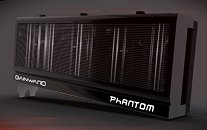Friday, June 21st 2013

Gainward GeForce GTX 780 Phantom Pictured
Gainward stands apart from the crowd with its unique Phantom line of VGA coolers, which features discrete fans that pull air into the aluminum fin-stack, rather that pushing air through it, resulting in a groovy board design. The company is close to unveiling its GeForce GTX 780 Phantom graphics card, and made a presentation about it. Pictured below, is a screen-grab from the presentation, which reveals an updated design for the cooler.
Cleaning up the discrete fans is now easier than ever, by simply turning out thumb-screws that hold each fan in place, and sliding them out. The cooler uses a slightly thicker aluminum fin-stack, arranged along the height of the card, to which heat is conveyed by five 8 mm-thick heat pipes. A base-plate draws heat from the memory, while a proper ridged metal heatsink draws it from the VRM. Speaking of which, the card uses an 8-phase VRM, with solid-chokes and DrMOS (driver-MOSETs, combine up/down FETs and driver IC into a single package). The card draws power from a pair of 8-pin PCIe power connectors.Find the video presentation after the break.
Cleaning up the discrete fans is now easier than ever, by simply turning out thumb-screws that hold each fan in place, and sliding them out. The cooler uses a slightly thicker aluminum fin-stack, arranged along the height of the card, to which heat is conveyed by five 8 mm-thick heat pipes. A base-plate draws heat from the memory, while a proper ridged metal heatsink draws it from the VRM. Speaking of which, the card uses an 8-phase VRM, with solid-chokes and DrMOS (driver-MOSETs, combine up/down FETs and driver IC into a single package). The card draws power from a pair of 8-pin PCIe power connectors.Find the video presentation after the break.

15 Comments on Gainward GeForce GTX 780 Phantom Pictured
Cleaning up the discrete fans is now easier than ever, by simply turning out thumb-screws that hold each fan in place, and sliding them out. The cooler uses a slightly thicker aluminum fin-stack, arranged along the height of the card, to which heat is conveyed by five 8 mm-thick heat pipes. A base-plate draws heat from the memory, while a proper ridged metal heatsink draws it from the VRM. Speaking of which, the card uses an 8-phase VRM, with solid-chokes and DrMOS (driver-MOSETs, combine up/down FETs and driver IC into a single package). The card draws power from a pair of 8-pin PCIe power connectors.
Find the video presentation after the break. [---]
View at TechPowerUp Main Site
One of my cards is a Gainward one and I had to peel off some stickers thus voiding my warranty to install a waterblock.
I'll surely avoid them both from now on.
When I call to talk about import EVGA 780 Classified distributor offer me Gainward 780 or Gainward Titan for good price.
I didn't agreed. I mean I start to laugh in one moment. Probably some guy who don't understand good market.
I wouldn't call them, I have lot of ASUS option but I build Classified PC when Haswell E show up and 780 Classy is important part of that.
And GTX780 is expensive card, because I decide NVIDIA in future I will choose Experts for NVIDIA-EVGA, specialized for them.
Yes
I can't clean my GIGABYTE card too without void warranty, same tell me for ex ASUS cards.
But with EVGA you can open card, put backplate, change cooler, install HydroCooper block, back stock cooler and no problems.
That is one more plus, not because cleaning only, because change paste after 12-14 months example.
I don't know different in temps example compare with dual cooler cards, but this Gainward Phantom look nicer than DirectCU and Lightening...
Pipes are inside...